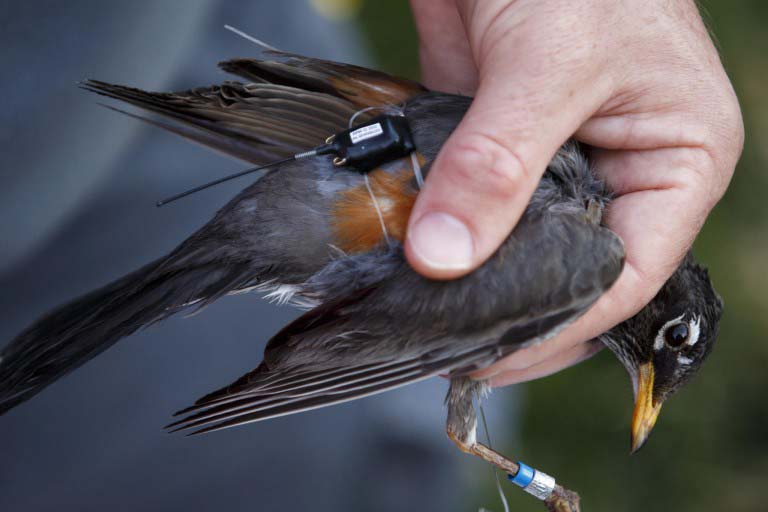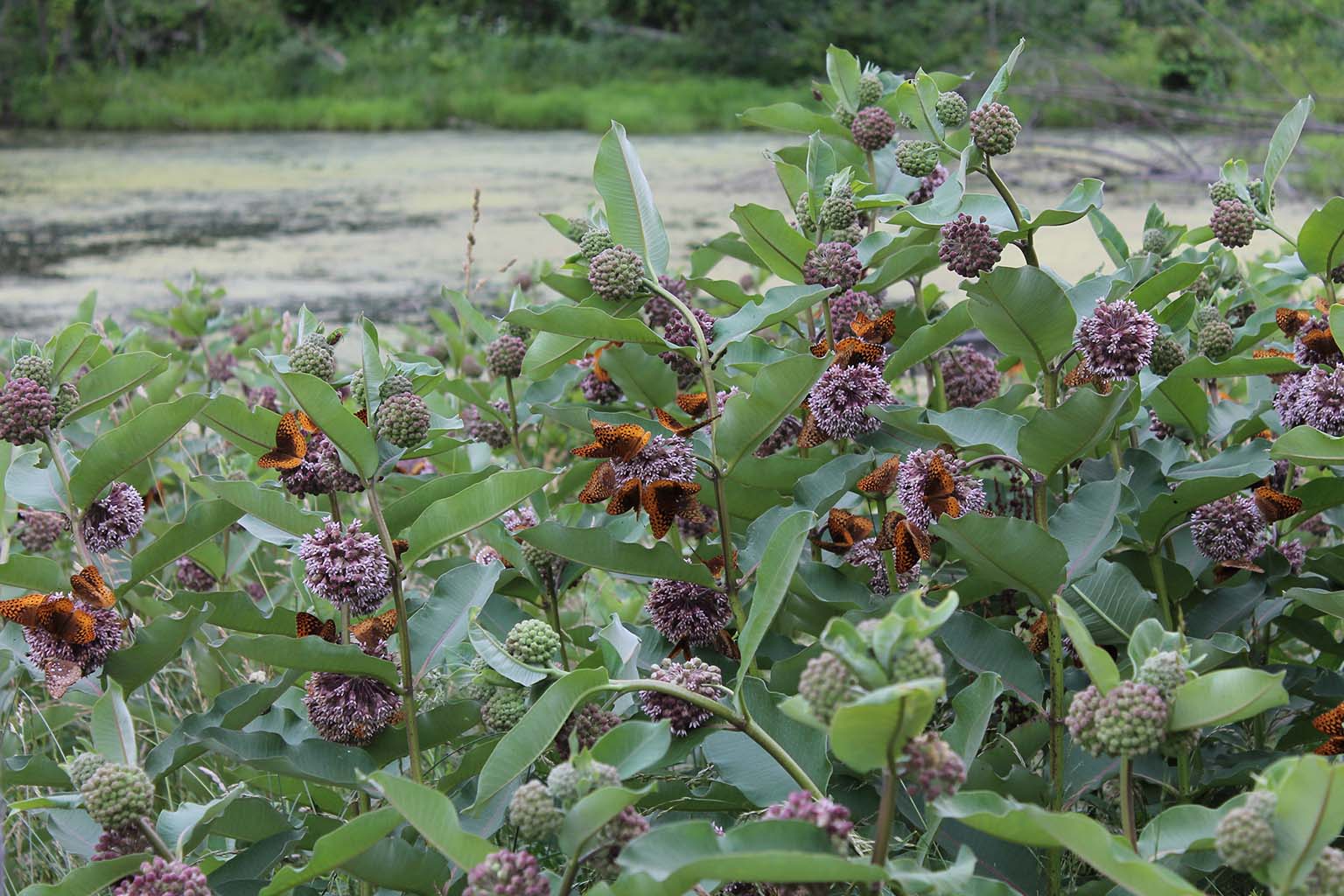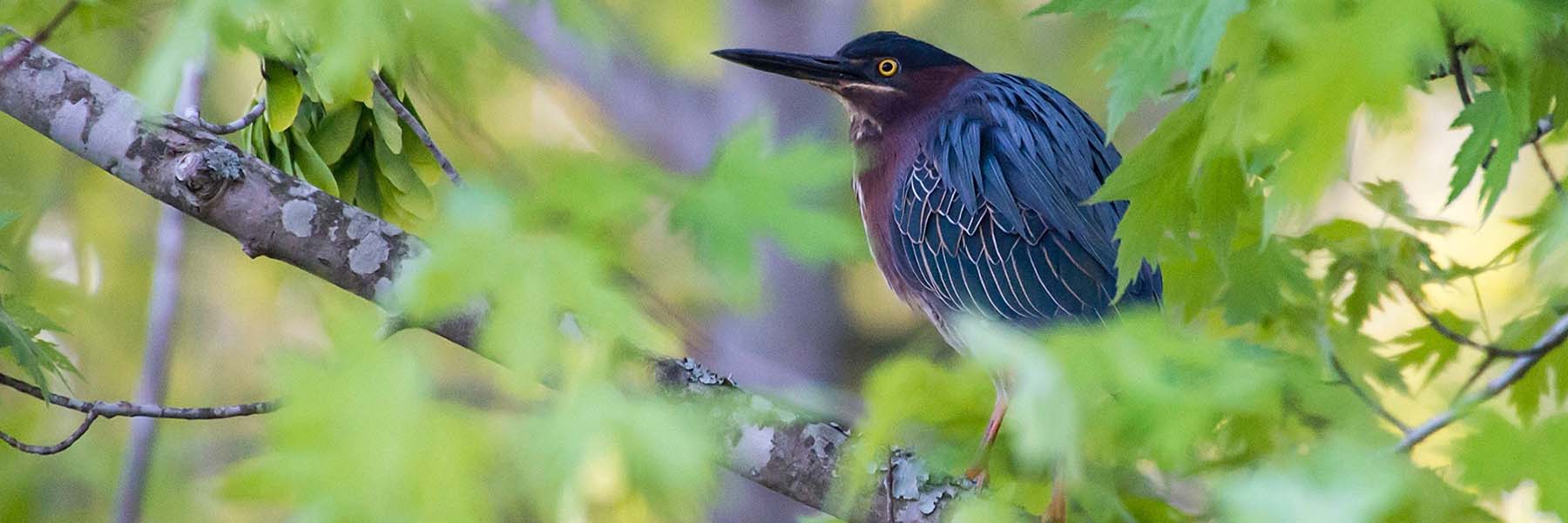BANNER IMAGE: A Green Heron peers out from its perch in a maple tree at Stillwater Marsh Water Fowl Resting Area near the IU Kent Farm Research Station. | Photo by Roger Hangarter
Research priorities and projects
Priorities
Initial research projects undertaken by the Midwest Center for Biodiversity integrate multiple priorities, including …

Migratory connections
To where do birds in the Midwest migrate after the breeding season?

Climate change impacts
How is climate change impacting the migrations and successful reproduction of migratory birds?

Disease transmission
What role do migratory birds play in disease transmission?

Urban and suburban impacts
How can we support migratory populations in urban and suburban areas?
Check out this article

In her excellent article "Keeping track of migrating birds, the ‘sentinels’ of our ecosystem," Rebecca Hill features investigations by MCB scientists Alex Jahn and Allison Byrd.
Explore the MCB research projects listed below to learn more about Jahn and Byrd's research as well as several other studies.
Projects
A number of research projects undertaken with support from the IU Grand Challenge Initiative "Prepared for Environmental Change" form MCB's research agenda. Projects include:
Andean Flamingos are facing a very high risk of extinction in the wild in the near future. Alex Jahn, MCB co-director, is collaborating with colleagues to track the birds' movements. With the information they gather, they will make recommendations to local government and non-government agencies across the range of the Andean Flamingo so that steps can be taken to protect the species.
In many places, dark skies at night are a thing of the past. Night-time cityscapes can be beautiful, but they are not so good for wildlife and sometimes not for us either. MCB scientists Devraj Singh, Dan Becker, and Ellen Ketterson are assessing the impact of ALAN (artificial light at night) on migratory and reproductive schedules and seasonal relapse in disease.
Birds provide ecological services by transporting pollen and seeds, but they can also transmit diseases such as avian flu, so it is important to learn how sites they visit are connected geographically. Do healthy birds travel longer distances than sick ones? Do they stop to rest less often when migrating? Are they more or less sociable?
The answers to these basic questions used to be beyond reach, but we now have electronic tags to report on the routes taken by birds and the distances separating their breeding and winter locations to establish patterns of connectivity. MCB scientists Alex Jahn, Geoffrey Brown, and Dan Becker are working on projects in this sector.
Bird species across the country are declining in abundance and diversity at an alarming rate. Human-fueled environmental change and interference are contributing factors, so understanding how birds respond to rapid change is vital to protecting them. One key to improved understanding of birds is long-term monitoring in a controlled environment. Unfortunately, many songbird species are reluctant to breed in captivity, limiting the types of studies that can be conducted. MCB researchers are discovering ways to improve the odds of successfully breeding captive birds.
Also watch a video of MCB Co-Director Ellen Ketterson talking about the loss of avian diversity.
Heat waves are becoming more intense and more frequent as the climate changes. Heat can affect an animal’s brain health and survival; however, we know far less about how behavior and physiology protect animals from heat. This is especially true for endotherms (warm-blooded animals) like birds, which are declining at alarming rates amidst rising temperatures. IU Biology scientists Mary J. Woodruff and Kimberly A. Rosvall are studying bird defenses against heat.
Indiana is well-situated to contribute to a large-scale bird-banding operation that can shed light on how birds are adapting to environmental change. The Kent Farm banding station is a part of an international collaborative program called Monitoring Avian Productivity and Survivorship (MAPS). Researchers with the MCB and volunteers capture birds, band them, and record information on multiple variables before releasing the birds back into the wild. As more data is recorded, future studies could contribute to solutions on how to conserve birds and their habitat.
Birds time their fall migrations to escape severe winter climate and their spring migrations to return as conditions ameliorate and are good for rearing young. As the climate changes, birds and other animals can become out of synch with the resources they depend upon. We are studying how birds vary in the amount of flexibility in reproductive and migratory timing as they adjust to the changing climate. MCB scientists Adam Fudickar, Allie Byrd, and Ellen Ketterson are working on projects in this sector.
Migratory birds provide essential ecological services such as pollination, seed dispersal, and insect control while also harboring the potential to transmit disease to humans and other wildlife. Over the past half-century, bird populations in North America have decreased by three billion, or about 29 percent. To protect birds and prevent disease transmission, a better understanding of bird migration is needed. Researchers at the Indiana University Midwest Center for Biodiversity are using multiple technologies and techniques—including Motus stations, GPS tags, and stable isotopes—to track birds more effectively and economically than ever before.
As climate change destabilizes environments across the country, it is vital that researchers find ways to monitor the changing habitats and behaviors of plants and animals.
One method is to use stable isotopes to evaluate species diets and migration in relation to climate and land-use change. Because isotopes of carbon, nitrogen, oxygen, and hydrogen vary in water and vegetation across the landscape, researchers can use those unique signatures to learn more about where animals have been and how they’ve survived.
Using isotopic signatures, researchers seek to answer questions about animals’ abilities to tolerate urban habitats, bird migration pathways and timing, and how changes in behavior may impact other processes, such as dispersal of zoonotic diseases carried by birds.
Staggering numbers of birds run into tall buildings while migrating and are killed, posing a serious threat to their populations. Buildings on university campuses, often lit through the night, also harm birds. The lights disorient birds during their migration and can also attract them, leading to often fatal avian window strikes. MCB scientists Sarah Wanamaker and Bryce Himebaugh are quantifying the problem and devising technology to increase the accuracy of the estimates in hopes of fostering policy change on light regimes.
Future projects
In the near future, MCB's natural and social scientists will pursue projects focused on invasive species, green infrastructure, environmental communication, losses of insect diversity, intersection of public and private lands, and threatened species.



